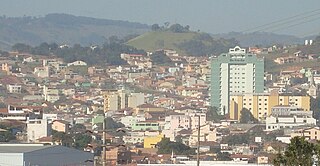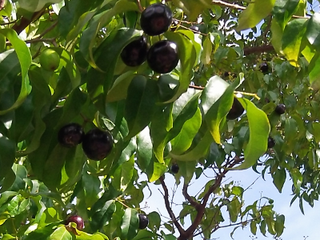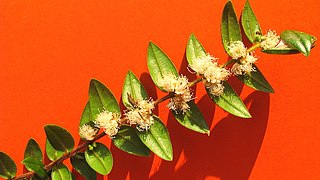Cambuí may refer to:
- Cambuí Municipality, a municipality in the state of Minas Gerais, Brazil
- Cambuím (disambiguation) or Cambuí, the common name for a number of species of plant in the family Myrtaceae
Cambuí may refer to:

Myrciaria dubia, commonly known as camu-camu, caçari, araçá-d'água, or camocamo, is a species of plant in the family Myrtaceae. It is a small bushy riverside tree from the Amazon rainforest in Peru and Brazil, which grows to a height of 3–5 m (9.8–16.4 ft) and bears a red/purple cherry-like fruit. It is a close relative of the false jaboticaba and the guavaberry or rumberry. As much as 2 to 3% of the fresh fruit by weight is vitamin C.

Myrciaria floribunda, commonly known as cambuizeiro, guavaberry or rumberry, is a species of plant in the family Myrtaceae. It can be found across South and Central America and the West Indies in dry or moist coastal woodlands, up to 300 metres above sea level. The guavaberry, which should not be confused with the guava, is a close relative of camu camu.

A jaboticaba, spelled jabuticaba in Portuguese, is a round, edible fruit produced by a jaboticaba tree, also known as Brazilian grapetree. The purplish-black, white-pulped fruit grows directly on the trunk of the tree, making it an example of 'cauliflory'. It is eaten raw or used to make jellies, jams, juice or wine. The tree, of the family Myrtaceae, is native to the states of Rio de Janeiro, Minas Gerais, Goiás and São Paulo in Brazil. Related species in the genus Myrciaria, often referred to by the same common names, are native to Brazil, Argentina, Paraguay, Peru and Bolivia.

Araguapaz is a municipality in northwestern Goiás state, Brazil. The population is 7,783 (2020) in a total area of 2,194 km2. It is a major producer of cattle.
Jaboticaba or Jabuticaba can refer to
Guayabillo is the common name for a number of species of plant. It may refer to:
Myrciaria plinioides, commonly known as camboim, cambuim, or cambuí, is a species of plant in the family Myrtaceae. It is a shrub that is endemic to Rio Grande do Sul in the south of Brazil.
Senador Amaral is the second highest city in Brazil (1,505 m [4,938 ft]), reaching near 1,620 m (5,310 ft) in some parts in the northern areas, nearly the Ponte Segura district, the highest point is an unnamed mount in Bom Repouso border at approximately 1,660 m (5,450 ft) above sea level. It is located in the Mantiqueira Mountains, south of Minas Gerais state. It is a small city, with a population of 5,361 inhabitants and approximately 2980 people living in the urban area. There was no asphalt or mobile phone signal in the municipality before 2007. Only Cambuí access, MG-295 is asphalted.
M. dubia may refer to:

Cambuí is a municipality in the state of Minas Gerais in the Southeast region of Brazil.
Guava are a type of tropical fruit, commonly from the species Psidium guajava, the "common guava". Guava may also refer to:

Eugenia candolleana, or rainforest plum, is a tree native from Atlantic rainforest of Brazil, known locally by the Portuguese names cambuí roxo or murtinha. It is quite rare in the wild, and has seen limited use in landscaping for its bright green foliage and purple-black fruits.
M. floribunda may refer to:
Camu may refer to
Cambuím, camboim, or cambuí are the common names for a number of species of plant in the family Myrtaceae.
Myrciaria delicatula, commonly known as cambuí uvaia doce, cambuí graudo, cambuim, or cambu branco, is a species of plant in the family Myrtaceae.

Myrciaria strigipes, commonly known as cambucá da praia or cabeludinha da praia, is a species of plant in the family Myrtaceae. It is an evergreen shrub or small tree, endemic to Bahia and Espírito Santo in the east of Brazil. The plant grows up to between 4 and 9 metres tall, and produces edible yellowish fruits between 22 and 28mm in diameter. Consumed raw, the fruit has been described as tasting somewhere between Myrciaria glazioviana and Plinia cauliflora.
Myrciaria tenella, commonly known as cambuí or camboim, which are also used to describe Myrciaria cuspidata and Myrciaria delicatula; or more specifically jabuticaba-macia, and cambuí-açu, is a species of plant in the family Myrtaceae.

The Immediate Geographic Region of Pouso Alegre is one of the 10 immediate geographic regions in the Intermediate Geographic Region of Pouso Alegre, one of the 70 immediate geographic regions in the Brazilian state of Minas Gerais and one of the 509 of Brazil, created by the National Institute of Geography and Statistics (IBGE) in 2017.